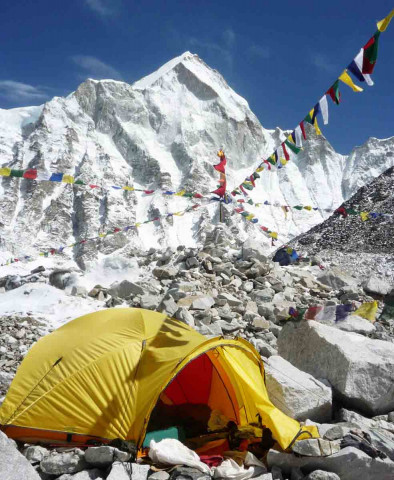Nepal’s earthquake caused Mount Everest to shrink: scientists
The world's tallest mountain may have lost a bit of height, but its in no danger of giving up its title

A general view from Everest Base Camp towards the summit of Mount Everest in Nepal. PHOTO: AFP
Home to the world's tallest mountain, Mount Everest, the earthquake caused devastation there with avalanches destroying the base camp and leaving at least 20 mountaineers dead. It also caused the mountain to shrink by an inch, revealed UNAVCO, a nonprofit geoscience research consortium.
The analysis was made on the basis of the data from the European Space Agency Sentinel-1A satellite, which crossed the affected area for the first time on April 29.
As soon as the fault between the India and Eurasia tectonic plates slipped and this caused the earthquake, strain was released that let the Earth’s crust to relax. This led to a slight reduction in the height of Everest, which stands 8,848 m (29,029 ft) tall.
Read: Nepal quake toll tops 7000
However, the Everest is currently in no danger of losing its title as the world's tallest mountain. Second placed K-2 (8,611 m high) should not get its hopes up at upstaging the Himalayan giant.
Roger Bilham, a fellow at the Cooperative Institute for Research in Environmental Sciences and a professor in geological sciences at the University of Colorado Boulder said that the Everest had shrunk by only one or two millimeters.
He told the The Huffington Post that the effect can be compared to suddenly releasing an eraser that's been squeezed. "Squeeze an eraser and it rises," he remarked. "Let go and it shrinks back to its original shape."
Furthermore, the Annapurna Range, another mountain located in central Nepal closer to where the earthquake occurred, grew not less than 20 centimeters, or roughly eight inches.
Read: Disease fears hit Nepal's quake-hit homeless
To top it all, an area around Nepal's capital city of Kathmandu was actually lifted up vertically by around three feet, as the analyses put forth by the German Aerospace Center. The area was estimated to be more than 55 miles long and 18 miles wide.
What helped the scientists more was the data gleaned by the Sentinel-1A satellite, making it easy to study the mechanics of the quake itself.
"We want to know which parts of the fault slipped," Tim Wright, a geophysicist at the University of Leeds, told the BBC. "
He added, “And that's important because it tells us those parts that did not, and which are still primed and ready to go in a future earthquake."
The article originally appeared on The Huffington Post


















COMMENTS
Comments are moderated and generally will be posted if they are on-topic and not abusive.
For more information, please see our Comments FAQ